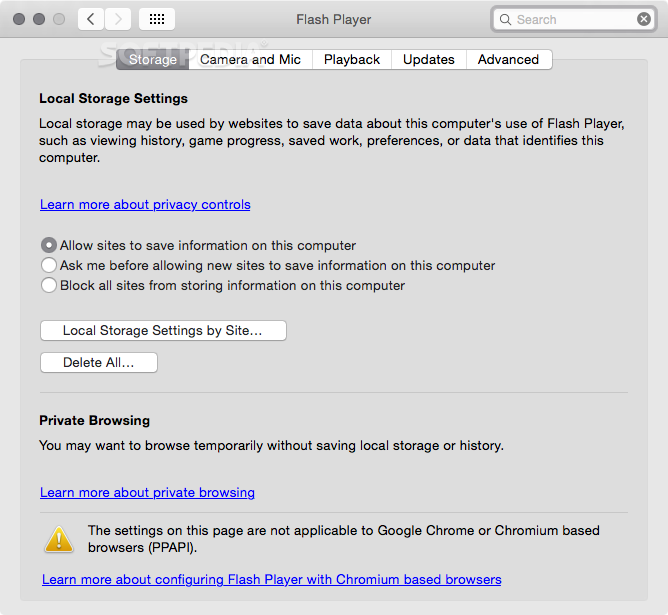- Flash Player Update Script for Mac OS X. GitHub Gist: instantly share code, notes, and snippets.
- Adobe Flash Player Complete Collection. A part of fpdownload.macromedia.com has been mirrored and is present in this torrent. Since Adobe has put an end to Adobe Flash Player series, this could be a complete collection of all versions of Adobe Flash Player. Get a specific version of archived Adobe Flash Player pack from this torrent and unpack it.
- Why wont this stupid program allow me to install flash player; Firefox button missing on imac with os x 10.9; Flash Plugin - Keep it up to date and troubleshoot problems; Adobe Flash plugin has crashed - Prevent it from happening again; Install the Flash plugin to view videos, animations and games.
- Run the uninstaller on Mac OS X 10.1 to 10.3. Download the Adobe Flash Player uninstaller: Mac OS X, version 10.3 and earlier: uninstallflashplayerosx10.2.dmg (1.3 MB) (updated 05/27/08) Choose Window Downloads to view the downloaded uninstaller. Save the uninstaller file in a convenient location.
- Install_flash_player_osx Intel.dmg
- Install Flash Player Osx Intel Dmg Free
- Install Flash Player Osx Intel Dmg Download
Go to Adobe's Flash Player download page and download the Flash installer. Click the menu button and then click Quit. Open the file you downloaded (i.e. In the Finder, open the Install Adobe Flash Player.app to run the installer, then follow the instructions. Flash Plugin Not Working.
So instead of adding yet another modification in the comments of a hint related to 10.5, I thought I would submit a new hint brining everything together from the old hint, its comments, changes needed for 10.7, and the missing items I have found. This provides a current version of the hint for 10.7 and presumably 10.8, though I have not been able to test on Mountain Lion.
1: Remove references to, and the stored passwords for, your local WiFi network.
- In the Finder, choose Go > Utilities.
- Open Keychain Access in the Utilities folder.
- If you don’t have a list of keychains on the left, choose View > Show Keychains.
- On the keychains list on the left, select the System keychain. There should be an AirPort network password item in the list for your local WiFi network. Select it and press Delete. Confirm that you want to delete the item and quit Keychain Access.
- Go to System Preferences > Network
- Select Wi-Fi from the list on the left and click the Advanced button on the bottom right.
- In the‘Preferred Networks: list, select your network and click the minus button below the list.
- Click OK and then Apply button in the main Network Preferences window.
- Click Turn Wi-Fi Off, then click it again to turn Wi-Fi back on. It should not connect to your network anymore (and should ask for a password if you try).
Install_flash_player_osx Intel.dmg
3: Boot your Mac into single user mode by restarting and holding down Command-S at startup.4: Mount the filesystem in write mode and delete the USERNAME home directory.
$ mount -uw /
$ rm -R /Users/USERNAME/ 5: Load OpenDirectory so we can remove the system’s record of USERNAME.
$ launchctl load /System/Library/LaunchDaemons/com.apple.opendirectoryd.plist 6: Find the UID of USERNAME.
6: Find the UID of USERNAME.$ dscl . -read /Users/USERNAME GeneratedUIDIn the next step, type in this UID where you see GENERATEDUID written.
7: Remove USERNAME from the systemwide admin group and then remove USERNAME’s record.
Install Flash Player Osx Intel Dmg Free
$ dscl . -delete /Groups/admin GroupMembers GENERATEDUID
$ dscl . -delete /Groups/admin GroupMembership USERNAME
$ dscl . -delete /Users/USERNAMEInstall Flash Player Osx Intel Dmg Download
8: Remove the Setup Assistant flag so that it runs when the Mac is started up.$ rm /var/db/.AppleSetupDone9:[optional] Remove the cache files and virtual memory swapfile.
$ rm -R /Library/Caches/*
$ rm -R /var/vm/swapfile*10:
$ shutdown -h nowIf you want to check that the Setup Assistant will run, you can turn on your Mac. When the Setup Assistant starts, just press cmd-Q on the keyboard and you will be prompted to shut down. Your Mac has been reset.
[
 kirkmc adds: I'm running this hint because it contains a lot of useful information. But I wonder why one can't simply erase the hard disk and re-run the installer to get everything back to its initial state. That seems a lot easier to me…]
kirkmc adds: I'm running this hint because it contains a lot of useful information. But I wonder why one can't simply erase the hard disk and re-run the installer to get everything back to its initial state. That seems a lot easier to me…] 
Adobe's only officially supported method of installation of Adobe Flash Player on OS X clients is via the installer application bundle in the Install Flash Player .dmg file.
Installation via the extracted pkg from within the application bundle does not update the Adobe Flash Player Installer Manager application located in /Applications/Utilities if it already exists, which can cause issues with inventory and reporting of an otherwise successful managed installation.
You can successfully deploy Flash Player for Mac clients using the Adobe's preffered method with a little tweaking of the application bundle:
- Copy Adobe Flash Player Installer.app from the installer .dmg to writeable media/volume (Desktop in my example)
- Edit the info.plist file in the Adobe Flash Player Installer.app to not show a dock item with the following commands:
- Zip the edited Adobe Flash Player Installer.app and add as a Software Inventory Item
- Create a Managed Installation
- Configure Manually
- In order to allow installation without a logged in user, use the following Installation Command (all one line):
-- edit 2013-07-30 15:42:18
To make managing the ongoing updates of the installer, I've simplified this to just use the original dmg from Adobe. This way, you don't have to bother with editing the files and only need to zip the dmg and replace the attached file on the Managed Install.
- Download Install_Flash_Player.dmg from Adobe
- zip Install Flash Player.dmg and attach Install Flash Player.dmg.zip to Managed Install
- Use the following installation command:
What this command does:
unzip dmg
mount dmg silently
copies the embedded .app file to system temp directory
unmounts dmg
edits the Application properies to run as an agent so it does not create a dock icon, and makes the file readable by all users
use launchd to execute the installer using bootstrap context of loginwindow in order to be able to run without needing a logged in user